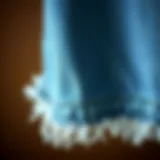Exploring Materials in Sandals: Characteristics and Choices


Intro
The world of sandals stretches far beyond mere aesthetics; it intricately weaves a tale of innovation, culture, and personal expression. With every step, sandals tell a story about the materials that comprise them—each fabric and texture carrying its own history and environmental footprint. As fashion evolves, the dialogue around sandal materials becomes increasingly relevant, reflecting not only current trends but also consumer desires for sustainability in footwear.
By embarking on this exploration, we'll peel back the layers of sandal fabric, examining what each material offers while taking note of modern shifts in its production and use. We'll look at what drives shopper choices—be it comfort, style, or ethical considerations. Ultimately, this journey aims to empower readers with knowledge that enhances their ability to make informed and conscious decisions the next time they find themselves choosing that perfect pair of sandals.
Whether you’re a fashion designer on the hunt for the latest trends or a retail worker aiming to understand customer preferences, this in-depth analysis is designed with you in mind, equipping you with insights that are as diverse as the sandals themselves.
Prologue to Sandal Fabrics
Understanding sandal fabrics holds significant importance, especially in today’s market where fashion trends shift faster than the wind. Choosing the right material goes beyond aesthetics; it impacts comfort, durability, and even the well-being of our planet. This section lays the groundwork for exploring the multifaceted aspects of sandal fabrics, helping readers appreciate their significance within footwear design.
Materials make or break any piece of footwear. While design and style may catch the eye, it's the fabric that ensures the shoes serve their primary purpose. A sandal that melds comfort with durability will always be a crowd-pleaser. A significant consideration when selecting a fabric is how it interacts with the elements. For instance, materials like leather might be optimal for longevity, yet can be cumbersome in hot weather, where breathable options like mesh or canvas shine.
In this article, we’ll unfold the layers of sandal fabrics, highlighting their unique characteristics and the benefits derived from each type. The focus will also be on historical contexts and innovations we see in the materials used today. By the end of this discussion, readers will not just recognize various fabrics but will also be equipped to make informed choices that align with their preferences and ethical considerations.
The Significance of Fabric in Footwear
Fabrics play a pivotal role in defining the overall experience of wearing sandals. It’s not just about what looks good; it’s about what feels good too. For example, a well-constructed sandal with breathable fabric tends to keep feet dry and comfortable, averting blisters and discomfort during longer wear.
Key elements to consider when discussing the significance of fabric in footwear include:
- Comfort: How the material breathes and cushions the foot.
- Durability: Resistance to wear and tear over time.
- Weight: Lighter materials can enhance mobility and reduce fatigue.
- Look and feel: The visual appeal and tactile experience that fabric offers.
By choosing wisely, consumers enhance their daily experiences with footwear, allowing room for confidence and style without sacrificing comfort.
Historical Evolution of Sandal Materials
The world of sandals tells a story rooted in ancient times, using a tapestry of materials that have evolved in unexpected ways. Initially, sandals were handcrafted from natural materials like leather, reeds, and even wood, depending on the region. Ancient Egyptians donned sandals made from papyrus, while Romans favored leather—each choice representing the available resources and cultural influences of their time.
In the centuries that followed, the advent of industrialization dramatically shifted the landscape of sandal making. Synthetic materials were introduced, leading to more innovative designs and mass production. By tapping into the likes of rubber and nylon, brands adapted to an expanding consumer market, offering diverse options for style and use cases.
This evolution reflects society’s changing relationship with fashion, sustainability, and functionality. While some may argue that modern materials achieve better performance, traditional choices remind us of the craftsmanship that came before. Each fabric type contributes to a greater narrative, illustrating how footwear has merged utilitarian needs with self-expression throughout history.
Common Fabrics Used in Sandals
Understanding the common fabrics used in sandals is crucial not just for consumers looking to make informed choices, but also for designers and retailers aiming to create functional and stylish footwear. This section outlines the characteristics, benefits, and considerations of various materials, enabling a better grasp of how fabric impacts the overall sandal design and wearability.
Leather: Timeless and Durable
Types of Leather
Leather stands out as a classic choice for sandals, rooted in a long history of footwear innovation. There are two primary types of leather commonly used: full-grain and top-grain. Full-grain leather is made from the top layer of hide while preserving its natural texture and imperfections, making it incredibly durable and breathable. Top-grain leather, in contrast, has been sanded and finished for a more uniform appearance, yet still retains decent durability.
The distinguishing characteristic of leather is its ability to age gracefully, developing a unique patina that many find attractive. This makes leather a popular option for those who appreciate longevity and aesthetics in their footwear. However, the treatment process can raise concerns about ethics and environmental sustainability, urging consumers to weigh these factors in their selections.
Care Tips for Leather Sandals


Caring for leather sandals requires attention to detail to maintain their appearance and longevity. Regular cleaning with a soft cloth is essential to remove dirt and moisture. Additionally, applying a proper leather conditioner keeps the material supple and helps prevent cracking. Adopting these care practices not only preserves the sandal’s look but also durability, ensuring that they serve well over the seasons. However, users should be cautious with water exposure and avoid harsh chemicals that can damage the leather's structure.
Canvas: Versatile and Breathable
Pros and Cons of Canvas
Canvas stands out for its versatility and lightweight qualities, making it an appealing choice for various sandal styles. The fabric's main advantage lies in its breathability, allowing for comfortable wear in warmer climates. Its affordable nature also adds to its popularity, permitting a wide array of vibrant colors and patterns.
However, canvas does have its downsides, most notably its susceptibility to water damage. Unlike leather, if it gets wet, it can lose shape and even become stained. Thus, consumers should carefully consider the environment where they intend to wear canvas sandals. If anticipated use involves splashes or rain, then canvas may not be the best option.
Styling Canvas Sandals
When it comes to styling, canvas sandals offer flexibility in outfit combinations. They can complement a relaxed beach look or be paired with casual shorts and a summer tee. The practical aspect of canvas also includes its lightweight nature, which is perfect for travel. Given their casual vibe, they may not be suited for more formal occasions, so always consider the event at hand.
Synthetic Fabrics: Innovation in Footwear
Common Synthetic Materials
Innovations in footwear have brought forth synthetic materials that mimic the beneficial qualities of natural fabrics while providing additional advantages. For instance, materials like EVA (Ethylene Vinyl Acetate) and polyester are recyclable and often water-resistant, catering to the demands of a fast-paced lifestyle. EVA, known for its cushioning properties, adds comfort, while polyester enhances durability.
These materials have carved their niches in the market. The breathing capacity and potential for colorful designs make them eye-catching and widely adopted in sandal manufacturing. However, it's essential to recognize that not all synthetic variants are created equal; some may lack breathability and may cause discomfort during extended wear.
Performance vs. Aesthetics
Within the realm of synthetic fabrics, there’s a constant balance between performance and aesthetics. Higher performance materials might prioritize features like durability and comfort, while others might lean into visual appeal without necessarily offering the same level of function. This creates an environment where consumers must decide what ultimately matters more to them—whether it’s a standout style or reliable performance for active use.
Mesh: Lightweight and Airy
Benefits of Mesh Construction
Mesh sandals appeal particularly for their lightweight and breathable nature. The fabric encourages airflow, providing comfort during hot weather. Another significant advantage of mesh sandals is their quick-drying properties—ideal for beach outings where water is involved.
While the mesh holds several advantages, it might not provide adequate support for long-distance walking. Thus, it's worth noting that while mesh is suitable for casual wear and light activities, it’s essential to follow up with supportive footwear for prolonged use, especially in more demanding environments.
Ideal Uses for Mesh Sandals
Mesh sandals shine in various settings, perfect for casual outings or beach vacations. Their airy nature allows feet to feel almost weightless, contributing to overall comfort during warm days. However, if a planned activity involves rough terrain, it’s wise to consider more rugged options. Therefore, knowing when and where to utilize mesh sandals can enhance user experience significantly.
Sustainable Fabric Options
In recent years, the textile industry has been faced with an increasing demand for sustainable practices, particularly in footwear production. Sandals made from sustainable fabrics carry not only the weight of environmental responsibility but also embody modern consumer values. The push for eco-friendly options aligns with a broader movement towards reducing our carbon footprint and supporting ethical sourcing. Consumers today are not just looking to step out in style; they are also making choices that reflect their commitment to the planet. Choosing sustainable fabrics, therefore, becomes a significant aspect in the sandal market, influencing design, production processes, and consumer choices.
Natural Fibers: A Return to Basics
Natural fibers represent a back-to-basics approach in sandal production, appealing to those interested in simplicity and minimal environmental impact. Among the frontrunners in this category are hemp and bamboo, both boasting unique characteristics that make them attractive options.
Hemp and Its Applications


Hemp offers a multitude of benefits when used in sandal production. One of its key characteristics is durability; they stand strong under various stresses and still retain their shape. This makes hemp sandals resistant to wear and tear over time. They also excel in moisture wicking, keeping feet cooler during hotter days. Besides, hemp is biodegradable, ensuring that it leaves a minimal ecological footprint compared to synthetic alternatives.
However, it’s not all sunshine and rainbows. While hemp production does have a lower environmental impact, there are still concerns about the cultivation process, including land use and agricultural practices. But in the right hands, these concerns can often be managed effectively. Overall, hemp provides a beneficial, sturdy choice for those looking to make a minimal impact with their fashion choices.
Bamboo as a Sustainable Choice
Bamboo, on the other hand, has emerged as a popular sustainable fabric due to its rapid growth and low agricultural needs. Not only does it grow quickly and require little water, but its ability to thrive without chemical pesticides makes it an attractive agriculture option. The fibers derived from bamboo are soft yet strong, allowing for comfortable designs that don't compromise on quality.
Moreover, bamboo has natural antibacterial properties, which add an extra layer of hygiene, making it well-suited for warm-weather footwear. However, these advantages should be viewed with caution. The process of turning bamboo into fabric can involve chemicals, which raises questions about sustainability if not managed properly. In essence, while bamboo is indeed a notable sustainable choice, it’s critical to ensure that the production process aligns with truly eco-friendly standards.
Recycled Materials: Giving Fabric a Second Life
Recycling has become a significant part of the sustainable narrative in the realm of footwear. Utilizing recycled materials not only helps reduce waste but also minimizes the need for new raw materials. This strategy is gaining momentum in the sandals market, with increasing number of brands adopting these practices.
Process of Recycling Fabrics
The process of recycling fabrics involves collecting pre-loved materials, which undergo a series of steps to be repurposed. This means breaking down old garments and transforming them into usable threads, which are then woven into new fabric. The core characteristic of this approach is its ability to lessen landfill waste and resource consumption.
However, the recycling process isn’t without its challenges. Technical limitations can hinder the quality of the resulting fabric. Furthermore, the energy requirements for recycling can sometimes offset the benefits. Despite these challenges, many brands are making strides forward in overcoming these barriers, proving that recycling fabrics is a worthwhile endeavor.
Brands Using Recycled Materials
Several innovative brands are at the forefront of integrating recycled materials into their sandal designs. Companies like Teva and Adidas have embraced this trend, utilizing plastic waste from oceans or used textiles to create sustainable and fashionable footwear.
These brands focus on highlighting the journey of their recycled materials, often educating consumers about the significance of their choices. By opting for brands that prioritize the use of recycled fabrics, consumers can directly contribute to reducing plastic waste problem while still enjoying stylish sandals. However, it’s essential to conduct some research and ensure that the brand’s practices are transparent and genuinely sustainable.
Comparative Analysis of Fabric Durability
Understanding fabric durability is essential when choosing sandals. Footwear not only needs to be comfortable but must also withstand daily wear and tear. Sandals are often exposed to various elements like heat, moisture, and different surfaces. Thus, an analysis of durability is critical for both consumers and manufacturers, guiding decisions that aim for longevity without sacrificing style.
Wear and Tear: Real-World Testing
Factors Influencing Durability
When considering durability, several factors come into play. Materials like leather typically stand strong against wear, but their longevity can also rely on how they're treated and maintained. Take, for instance, full-grain leather, known for its thickness and ability to develop a patina over time. This characteristic can lead to a more personalized, unique appearance, making it a favorite among consumers.
On the other hand, environmental influences like humidity and sunlight can cause materials to degrade faster. For synthetic fabrics, the weave and finish significantly affect durability. A tightly woven nylon may last longer than a loose weave meant for summer wear. Many consumers often overlook these details in favor of a bargain, which could lead to discomfort when they find their chosen sandals falling apart after a single season.
Consumer Feedback on Various Fabrics
Customer reviews provide an invaluable perspective on fabric performance. When you sift through platforms like Reddit and specialized footwear forums, a common thread emerges: many users favor brands that prioritize durability. For example, sandals crafted from high-quality rubber are often praised for their resilience against harsh environments.
One unique revelation is how preferences vary by lifestyle. A traveler might prioritize sandals that are lightweight and packable, while someone in an urban setting might lean towards sturdier options that can handle varied terrain. This consumer feedback shapes production trends, pushing brands to focus on fabrics that not only look good but withstand the demands of daily life.
Longevity: How Fabric Choices Affect Lifespan
The life of a sandal isn't solely dependent on the fabric itself but also on how that fabric interacts with the user's lifestyle. For instance, a sandal made from breathable mesh might be perfect for hot days but could wear out if used extensively on rugged paths.


Consequently, understanding one's personal use can direct the selection of materials. A cotton canvas sandal can be valuable for casual wear but may not survive the rainy season as well as rubber options. Choosing the right material, therefore, isn't just a matter of preference; it can significantly influence the lifespan, comfort, and satisfaction for the user.
"Choosing the right fabric can be the difference between a pair of sandals that last a season or several years."
Aesthetic Considerations in Fabric Selection
The choice of fabric in sandals goes beyond mere practicality; it plays a crucial role in personal expression and overall aesthetics. For fashion designers, stylists, and retail workers, understanding the influence of fabric can elevate the appeal of sandal offerings. Selecting fabrics that resonate with style trends and consumer preferences is essential, as the right materials can significantly impact the visual charm and perceived value of the footwear.
When considering aesthetic elements, one must focus on how well the fabric harmonizes with design principles. Color, texture, and patterns can make or break an outfit. If someone picks a pair of sandals that clash with other elements in their wardrobe, style suffers, and that’s a miss for both consumer and retailer alike.
Moreover, fabrics can convey messages. For instance, sleek leather may impart sophistication, while canvas could project a more laid-back vibe. Thus, the implication of fabric selection stretches from fundamental design choices to marketing narratives. A well structured approach to fabric choices can help in tapping into the emotional aspects of consumer decisions.
Color and Texture: Impact on Style
Color and texture serve as the visual language of sandals, guiding consumers in their choices and influencing their fashion narratives. Each color can evoke distinct emotions and set a tone. For example, vibrant hues such as yellows and reds are often linked to warmth and energy, while muted tones like grays and browns can exude calm and reliability.
Furthermore, the texture of the fabric adds another layer of complexity. Smooth fabrics like patent leather can create a sleek, upscale appearance, suitable for more formal settings. In contrast, textiles with a rougher texture can offer a casual, bohemian feel. Consumers might lean into materials that not only look good but also feel good against their skin. Therefore, the tactile qualities of sandals could sway purchasing decisions.
It's prudent for retailers and designers to stay informed about color trends and emerging textures in the footwear industry. Keeping an eye on runways, fashion blogs, and color-predicting services can be beneficial in lining up product offerings with buyer expectations.
Prints and Patterns: Expressing Individuality
In the world of fashion, prints and patterns are the playground for creativity. They allow wearers to tell their own stories, channel their personalities, or make bold statements. In sandals, the incorporation of patterns—floral, geometric, or abstract—can transform otherwise simple designs into eye-catching pieces.
Offering a range of prints can attract diverse consumer bases. For the adventurous spirit, tropical prints might echo a love for travel and exploration, while minimalist designs can appeal to those who value subtle sophistication.
"Fashion is an instant language." — Miuccia Prada
Additionally, the choice of prints can align with ongoing social and environmental movements. Designs that embrace cultural art forms or eco-friendly motifs resonate with socially conscious consumers, providing an additional layer of appeal. The balance between unique designs and market demands presents an opportunity for creativity in fabric selection. For fashion professionals, understanding this dynamic is key to developing products that resonate deeply with consumers.
In short, aesthetics in fabric selection are paramount. From colors and textures to prints and patterns, every element plays a role in defining the sandal's character. For designers and retailers, leveraging these aspects thoughtfully can significantly enhance product allure and consumer engagement.
Epilogue and Future Directions
In the ever-evolving footwear industry, the exploration of sandal fabrics brings to light critical insights into both consumer choices and manufacturing practices. As styles shift and ecological awareness grows, understanding the dynamics of fabric selection becomes paramount not only for the buyers but also for those in the fashion and retail sectors. This discussion goes beyond just aesthetics—it's about sustainability, durability, and ethics, all intertwined in the fabric of our everyday lives.
Emerging Trends in Sandal Fabrics
Sandal fabrics are witnessing a transformation, reflecting broader fashion trends and technological advancements. One upcoming trend is the rise of bio-based materials, designed to lessen the environmental impact. For instance, more brands are now using plant-derived leathers or algae-based fabrics. This approach reduces reliance on traditional leather, which involves high resource use.
Moreover, customization is becoming popular. Consumers are no longer satisfied with one-size-fits-all solutions. Companies are adopting digital printing techniques that enable intricate designs and personal choices on sandal fabrics. This trend opens up avenues for both artistic expression and marketing strategies that cater to individual tastes.
Lastly, lightweight and modular designs are gaining traction. Sandals with interchangeable parts allow wearers to mix and match elements like straps and soles, which not only enhances utility but also promotes a circular economy. As fabric innovations continue to surface, staying aware of these trends could bolster competitive advantage in the market.
Consumer Responsibility in Fabric Choices
Consumers wield significant power in shaping the future of sandal production by choosing their fabric wisely. It’s vital to recognize that every purchase impacts the environment and the economy. As awareness of sustainable practices increases, consumers are encouraged to opt for brands committed to eco-friendly materials and ethical labor practices.
Additionally, exploring the "life cycle" of a product helps buyers make informed choices. Understanding where the material came from, how it’s made, and what happens when it’s no longer useful fosters a deeper connection between the consumer and their sandals.
"What we choose to wear should align with our values; our fabric choices speak volumes about who we are."
Investing in sustainable options is not just a trend; it’s a responsibility. Going forward, the responsibility of educating ourselves and one another lies with consumers, which could eventually lead to significant shifts in production norms and labor practices across the industry.
The knowledge acquired in exploring these fabric options is essential for fashion designers, stylists, and retailers. The future of sandal fabrics is not merely about seeking comfort or style; it encompasses a broader narrative on sustainability and ethical practices that can shape the industry as a whole.















